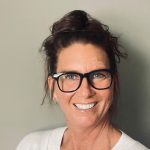Committee Appoints Whitney Gould to Planning Commission
Approving Whitney Gould‘s appointment to the City Plan Commission was the highlight of this meeting. The Committee made it clear that in her former position as the Journal Sentinel’s architecture writer she played an important role in improving Milwaukee’s urban environment and hoped she would bring her enthusiasm and knowledge to the Commission. The Committee also approved resolution 071307 which if approved by the full Common Council will allocate $1.4 Million dollars from the Housing Trust Fund to support five affordable housing projects. One example of these projects is the St. Catherine’s Residence at 1018 E. Knapp Street. It will receive $264,000 to build affordable housing for low-income women and it is already under construction. Alderman Michael Murphy pointed out that this $1.4 million will generate $26 million worth of development and went on to say that these projects do two things “one economic development and… two do the right thing”. The Northwest Side Area Comprehensive Plan was presented again as it had been held before to allow the Department of City Development to address issues that the committee felt the plan didn’t incorporate. Specifically items were added to insure existing rail corridors are reserved for future mass transit options and encouraged creating transit oriented development projects along those rail lines if they are ever converted to passenger service. Other areas of that plan that were improved included refinements of the 76th and Good Hope project, additional recommendations for the vacant transit hub at 76th and Mill, and addressed the potential reuse of Timmerman Airport if it were to be closed. One setback for the project was Alderman Jim Bohl‘s push to remove DCD’s suggested language regarding cul-de-sacs and their desire to better connect streets. This prompted Alderman Mike D’Amato to take a light hearted shot at Bohl by saying, “we hope you haven’t eliminated all the sidewalks from the Northwest side”. Additionally two closed sessions were held to discuss strategy with the City’s lawyers regarding the court case Dawn McCarthy vs. the City of Milwaukee. This case involves the City’s handling of the development of a City owned surface parking lot on Downer Ave. Despite the courts apparent concern the judge hasn’t stopped construction and development continues at a brisk pace.
Jan 31st, 2008 by Dave ReidThe Future of the Milwaukee Coast Guard Station
DSC00669 Originally uploaded by benditlikebecker13 The Daily Reporter has an article that takes a look at the recent events surrounding the proposed demolition of the Milwaukee Coast Guard Station near McKinley Pier. It’s sad to see a landmark go, but the building is reportedly past the state of cost-effective repair. Most importantly, it’s essential that what replaces it encourages the embracing of the lakefront. The planned pavilion seems to largely accomplish this goal. I think there is a still a market for a commercial development, even with the nearby Alterra. One that both embraces the lake and the nearby Lincoln Memorial Drive. Most of the development on the lake is auto-dependent, and it would be nice to see pedestrian-centric development where the old station was, especially with the nearby Brady St pedestrian ramp. You may ask why I’m so in favor of development with a planned park already on the drawing board, but I honestly think we have plenty of open space on our lakefront already. We need something to draw people to that open space outside of holiday weekends, and environmentally-responsible development would help achieve this. Alterra is a great start, but it needs to be paired with something else. Barnes & Noble with an all glass lake facing side? A clothing store? Parks are only useful if there are people there to use them, and all too often I think our Lake Michigan coastline is underutilized. We want people to have a reason to walk and enjoy the lake, not to drive by it at 45 miles an hour.
Jan 30th, 2008 by Jeramey JanneneListen to Super Tuesday coverage on WUWM
On Tuesday, February 5 from 7 to 9 pm, WUWM 89.7 FM – Milwaukee Public Radio will carry NPR’s Special Election Coverage of the Super Tuesday primaries and caucuses. With competitive races in both parties and a chance that there could be at least one presumptive nominee by the end of the night, NPR will begin providing live coverage of the primary/caucus results at 7 pm. NPR will host coverage from Washington D.C. with updates from NPR reporters in every key state. Election related material will be updated and carried throughout the evening, as dictated by the news, including candidates’ speeches. Extended coverage may air until 1 am. WUWM programming will be pre-empted for this coverage. Listen for coverage about the primaries in Alabama, Arizona, Arkansas, California, Colorado, Connecticut, Delaware, Georgia, Idaho, Illinois, Kansas, Massachusetts, Minnesota, Missouri, New Jersey, New Mexico, New York, North Dakota, Oklahoma, Tennessee, Utah, American Samoa, and the caucuses in Alaska, American Samoa, Colorado, Idaho, Kansas, Minnesota, Montana, North Dakota, and the Republican Convention in West Virginia. Additional reports will air during NPR’s Morning Edition on Wednesday, February 6 from 5 to 9 am. Very exciting.
Jan 30th, 2008 by Vital ArchivesState of the City Address
Mayor Barrett will share his vision for Milwaukee. Location: Direct Supply 6663 North Industrial Road Thursday, February 14 at 7:30 am.
Jan 29th, 2008 by Dave ReidNew Pix Now in our Photo Gallery!
Check out the pictures from our Gallery Night show, "Family Album," held January 18 at our new office. If you weren’t there, you probably know someone who was. Click here to go to the Gallery.
Jan 29th, 2008 by Vital ArchivesA SMALL ARMY OF LITTLE GOLDEN MEN
Jan 29th, 2008 by Vital ArchivesYour Support
Jan 29th, 2008 by Vital ArchivesBody Worlds, Gunther Von Hagens & life itself
Since seeing the show at the Milwaukee Public Museum when it opened two weeks ago, I’ve been thinking a lot about Body Worlds, and I’ve been thinking a lot about Gunther Von Hagens, the German scientist and provocateur behind the international museum sensation. His name (and his image) is plastered all over the exhibition, and his vision is not just overt – it’s his signature. Von Hagens, with his trademark black fedora, sees himself as a maverick anatomist, a Renaissance man and an artist – a modern-day Leonardo da Vinci whose detractors are merely ignorant or unwilling to see the bigger picture. To the great writ of history, Vesalius is not a grave robber or an exhibitionist, a picture so many people are eager to paint of Von Hagens. Von Hagens, I assume, does not think history will treat him with such ill will, either, and in time, they will come to understand what we view now as grotesque eccentricities – his enduring fascination with public autopsy and dissection, for example. The bio on the Body Worlds website says it all: Gunther von Hagens’ life reads like an archetypal scientist’s resume — distinguished by early precocity, scholarship, discovery, experimentation, and invention. It is also the profile of a man shaped by extraordinary events, and marked by defiance and daring. Von Hagens’ two year imprisonment by East German authorities for political reasons, his release after a $20,000 payment by the West German government, his pioneering invention that halts decomposition of the body after death and preserves it for didactic eternity, his collaboration with donors including his best friend, who willed and entrusted their bodies to him for dissection and public display, and his role as a teacher carrying on the tradition of Renaissance anatomists, make his a remarkable life in science. Body Worlds, amid all of its shock and bravura and bragging feats of technique, carried one-word message for me, a word the Von Hagens publicity machine has used to describe the mastermind himself: defiance. Body Worlds is full of real displays of things that kill us – aneurysms and hemorrhages, cancerous growths, lungs clogged with tar – but above all it attempts to suggest that with science (and in particular with plastination) we have found a way to make the decay of the mortal body avoidable and therefore impotent; moreover, we have managed to make it possible for bodies in death to do what they could not do in life. It is likely – even probable – that the bodies posed as ballet dancers, gymnasts, horsemen, basketball players, skateboarders or practitioners of Tai Chi never did such things when they were alive. There’s a defiance, too, of the way we practice science today – with our heads, and not with our hearts – that Von Hagens is trying to challenge. By displaying the body in all of its grace, it is written in a Body Worlds text panel, it becomes evident to the viewer that something is missing – the […]
Jan 29th, 2008 by Amy ElliottA Hungry Nation
The presidential campaign of Barack Obama received a stunning boost this week after scoring a huge victory in South Carolina’s primary Saturday followed by endorsements from Caroline Kennedy, Sen. Edward Kennedy, and other members of one of the royal families of the Democratic Party. Much has been made about the negative tone that has recently permeated the contest between Obama and Hilary Clinton with most of the blame falling on the Clinton camp. To his credit, Obama has tapped into a positive vein that seems to be surging throughout the country at just the right time for his campaign. His “Audacity of Hope” rhetoric and determination to run an inclusive campaign contrasts sharply with the image projected by Sen. Clinton, her former president husband and her many experienced surrogates. Her campaign is heavily invested in promoting her not only as more experienced at governing but also more skilled at defending herself from the negative attacks that the Republicans will direct at whichever candidate the Democrats nominate. At this point in the campaign, the Clinton machine appears seriously out of touch with the mood of the nation. While the candidate and her supporters deny introducing the issue of race, you have to scratch your head and wonder “What was he thinking?” when you hear Bill Clinton dismiss Obama’s success in South Carolina by comparing it to Jesse Jackson’s victory in 1988. Coupled with former Atlanta mayor and United Nations ambassador Andrew Young’s absurd remark that Bill Clinton is more “black” than Obama because he bedded more black women and former Nebraska Sen. Bob Kerrey’s repeated references to “Barack Hussein Obama” calls into question the whole notion that the Clintons offer the benefits of a well-oiled election machine. Clearly, it’s too early to call this race over. Only a fraction of the delegates necessary for nomination have been chosen. Tsunami Tuesday is next week when more than 20 states hold primaries and about 40 percent of the number of delegates needed to win will be divided up. But unlike the Republicans, the Democrats divide states up proportionately so that it is very likely that neither Obama nor Clinton will be in a position to declare the race over anytime soon. With all due respect to John Edwards, his inablity to win any of the early contests has made it difficult to imagine a scenario where he can catch either of the frontrunners. When asked, voters generally complain that there is too little attention paid to substantive issues and too much on the horse race. At this point, that seems a bit beside the point, at least as far as the Democratic contest goes. For one thing, there are very few significant differences between the two. Policy wonks will note that Clinton’s health care proposal pledges to provide universal access, while Obama’s falls short of that standard, popular as it is among the party faithful. But on Iraq, the economy, and so many issues their differences are minimal. The key variable which may […]
Jan 29th, 2008 by Ted BobrowFurther Considerations
In part one of my look at the Inova/Kenilworth exhibition (now – March 14), I signed off with a few questions for the exhibit’s curator, Nicholas Frank. Because there has been controversy about the balance of men vs. women receiving Mary L. Nohl Fellowships, and because the current Inova/Kenilworth event features four women and one man, I thought this might be his way of smoothing things out. Here’s his reply: My programming isn’t a direct response to the Nohl Fellowship situation, because the problem is not with the Nohl program; it exists in the art world at large. I don’t think it’s difficult to program excellent exhibitions that reflect the actual gender balance among practicing artists. He continued his comments with some thoughts on shaping shows: I curate to reflect what artists are doing. The shows need to be relevant to the general art-going public, and also to the university audience, because we want Inova to be a curricular resource within the Peck School of the Arts. The drawing show illustrates the rise of drawing and narrative strategies among contemporary artists, and is useful for visual art faculty and students in that it expands notions of what drawing is and can be. There are sculptural, photographic and conceptual elements at play in this show, too. In an earlier conversation, Frank told me he considered 10 artists; he may possibly include the five who didn’t make the cut in a future show. I assume that they were all good choices, simply because Frank has a great eye for what works and what doesn’t. Curators must deal with all kinds of problems: availability of work, space and scheduling, which may conflict with artists’ other jobs. It’s a lot to consider, and Inova/Kenilworth is only one venue under the Peck banner; Frank also curates Inova/Arts Center and Inova/Zelazo (Mary L. Nohl Galleries). To give you an idea of how interwoven it all is, on February 6, Claire Pentecost, who is participating in the current Kenilworth show, will consider the “great tradition of drawing and its current place as a mediator between self and the social” at the Arts Center lecture hall. As Frank noted in his statement, the show includes “sculptural, photographic, and conceptual elements.” As a unit, the entire exhibit is provocative, but not over-the-top, and from my standpoint the drawing theme holds true while conveying social anxieties. This is no easy trick, for how does a fine artist use words like “flatulence” and “poop” (and other arguably vulgar words) in a way that makes you want to keep reading? Deb Sokolow does it via story-telling. Her choice is freedom of expression; she almost dares you to hang in there, to see if the text and images (attached to several walls with push pins and tape) will lead you to a satisfactory end. But don’t expect her tale to necessarily end well. Unless you are a true fan of the wild, it takes time to explore her work (she’s a fan of […]
Jan 28th, 2008 by Stella CretekThe Kennedy family endorses hope
Jan 28th, 2008 by Vital ArchivesWeekly Milwaukee Development Bookmarks
Articles from the past week covering development in Milwaukee. JS Online: Approve the compact and protect the Great Lakes JS Online: Editorial: Climb on board or get out of the way JS Online: Mortgage refinancing rush is on JS Online: Sounds of silence JS Online: Developer looks to expand student housing complex JS Online: Partners hope custard stand sweetens North Ave. economy Ribbon cutting ceremony planned for Park East development – Small Business Times
Jan 28th, 2008 by Dave Reid




















